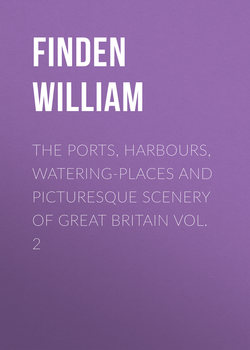Читать книгу The Ports, Harbours, Watering-places and Picturesque Scenery of Great Britain Vol. 2 - Finden William - Страница 2
THE MERSEY. FROM LIVERPOOL
Оглавление"A thousand keels the subject wave divide, —
Float with the flow, or stem the ebbing tide, —
Winged messengers that haste, with sails unfurl'd,
To barter produce with some distant world! —
With oar and paddle, sail and thundering steam,
They row – they cleave – they plough the Mersey's stream;
That stream, which, fretted by a thousand prows,
No silent rest, no liquid slumber knows;
Whate'er the hour, whatever wind prevail,
Behold the outward and the homeward sail!"
The Mersey is to Liverpool what the Thames is to London – the grand channel of mercantile prosperity – the main artery that carries health and vigour into the heart of the city, and thence distributes them by a thousand ramifications through all classes of the community. The navigation of this river has long been an object of primary import to the prosperity of our national trade; and therefore every suggestion which promised to obviate and remove those impediments which nature had thrown in the way, has been met with the greatest promptness and liberality. Whatever it was possible for art to accomplish has been attempted, and that so successfully that, if the ultimate object has not yet been obtained, the navigation of the Mersey has at least been rendered comparatively safe and expeditious. The grand enterprise for facilitating the intercourse between Liverpool and Manchester was commenced in 1720, when a canal was formed, and the navigation of the Mersey and Irwell was so greatly improved, that the "flats" – which were previously ten or eleven days in going from one town to the other – could now, by taking advantage of the tide, accomplish the same distance in as many hours. How amazingly this distance has been again shortened in our own times, by the introduction of steam power, is familiar to every one.
The rise and expansion of Liverpool – in all that regards it as a mercantile emporium – have taken place within the last two centuries. In 1650, the town – a mere fishing hamlet – consisted of only five or six streets. A pool, branching from the river, extended over the space now occupied by the new Custom-house and the three streets adjoining; and, for the convenience of intercourse, a ferry-boat was kept at the corner of Church-street and Whitechapel. This ferry was at last superseded by a bridge, erected by the proprietor of the land, Lord Molyneux; and since that period the advancement of the Mersey in the list of great navigable rivers has been unprecedentedly rapid and successful. The grand municipal improvements, however, have all been effected within the last century. During that interval, splendid squares, streets, and public monuments have sprung up into existence. Previously to that epoch there was no spirit, no scope for commercial enterprise, and consequently no harbour, nor dock, nor warehouse. But now spacious harbours extend for several miles along the bank of the Mersey: on the bosom of the river stately merchantmen, outward or homeward bound, laden with the produce of every clime, are continually passing and repassing; while the usual embellishments which follow a train of successful industry are apparent at every step of our progress, adding ever varying features of beauty and animation to the landscape. He who would form a just estimate of the vast and unlimited resources of this great commercial city, should spend at least a day, partly in a promenade along the banks, and partly on the spring-tide of the Mersey.
This river is navigable for vessels of considerable burden so far as the mouth of the Irwell, – a distance of thirty-five miles from Liverpool. It derives its source from the confluence of several small streams on the Cheshire and Derbyshire frontier, and pursues a serpentine course, gradually inclining to the south-west. Its largest tributary is the Irwell, which falls into it near the village of Flixton, seven miles from Manchester. A little below Warrington, the Mersey expands into a broad arm of the sea, and turning abruptly to the south-west, contracts its channel as it passes Liverpool to about three quarters of a mile in breadth; but in proceeding farther inland, it again increases its width to more than three miles. This peculiarity is very advantageous to the port, as the great body of water, passing and repassing at every tide, keeps the navigation of the Mersey always open. A range of sand banks run parallel with the coast for many miles, but several channels intervene, giving sufficient depth for vessels of the heaviest draught at high water, at which time the Mersey presents the most interesting and striking scene, – particularly when a westerly wind favours the arrival of the numerous fleets destined to this port, bearing the flags and freighted with the produce of all nations that have found a place in the chart of commercial enterprise.
